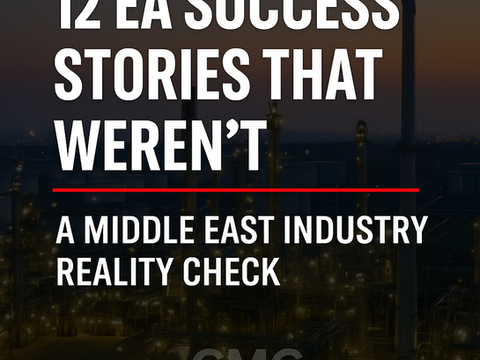top of page

Enterprise Intelligence
Transforming Strategy into Execution with Precision and Real Intelligence

CEO
Strategic intelligence


Case ME2 : How a Major Gulf Bank Mistook IT Blueprints for Enterprise Architecture 💲
This isn’t Enterprise Architecture for a Bank.
This is an IT roadmap, wearing a borrowed title.
If 12 of the 15 critical banking functions were never touched, it’s not EA. It’s IT transformation mislabelled as Enterprise Architecture


Case 1: High Ambition, Low Altitude: How a National Airline Mistook IT projects for Enterprise Architecture of Airlines 💲
This “Enterprise Architecture” covered perhaps 2–3 of the airline’s 15 core departments – maybe ~20% of the enterprise – leaving the other ~80% of the organization unmapped and unmanaged by any unified architecture.


12 EA Success Stories That Weren’t : A Middle East Industry Reality Check 🆓
Across the Middle East, “Enterprise Architecture” has become a brand — a badge claimed by banks, airlines, ministries, telecom giants, and consulting firms alike.
But behind the banners and certifications, a pattern reveals itself.


Is the U.S. Economy Just the World’s UI?
Because when you trace the actual enterprise layers—chips, infrastructure, manufacturing, logistics, even payment rails—the story flips.
The U.S. might look like the world’s tech leader. But in reality, it’s just the interface layer.


The Myth of U.S. Dominance: In Most Global Markets, #1 Isn’t American
or decades, we’ve been sold a global narrative: The U.S. leads. The rest follow. But if you strip away the branding and look at system ownership, the story changes.
Because while the U.S. may dominate valuation charts, it no longer owns the back-end infrastructure in most of the critical systems that power modern life.


U.S. GDP is $29 Trillion. But 20 Companies Are “Worth” Over $35 Trillion.
And yet, just 20 companies, including Apple, Microsoft, Amazon, Nvidia, Google, and Meta, have a combined market cap of over $35 trillion. How?
What are we really valuing here? Because if a handful of companies can be “worth” more than the entire country’s output, we’re no longer talking about value—we’re talking about belief.


AI Is Nothing but Efficient Automation
The real journey didn’t begin with ChatGPT. It began in 1820, when someone stopped trying to breed faster horses and started designing a mechanical calculator for reducing manual mental labour. That wasn’t a product. That was the first real AI.


Amazon Is Google Plus Apple. But It’s Also the System Neither of Them Built.
Amazon didn’t build an enterprise anatomy. But it built a portfolio of internal tools aligned with its enterprise functions. And that gave it leverage that others outsourced.


Sundar Pichai at Google. Satya Nadella at Microsoft. Arvind Krishna at IBM Perfect CEOs for Delivering Cost Arbitrage
There’s no shame in operational excellence. But there is danger in confusing offshoring efficiency with enterprise longevity. Sundar, Satya, and Arvind were the perfect CEOs—for that phase. But if that phase is ending—and all signs say it is—Then these companies need more than a new tool, more than a new face.


What If Google Is Sold for $1 in 2045 Just Like Once British Steel for £1
But anatomy is what allows you to shift, adapt, regenerate. Without it, you're only as alive as your product's popularity. And the moment that fades?
Your market cap goes to zero. Your valuation vanishes. And you’re bought for $1.
Not because you’re worthless. But because you never built what could survive you.


You Thought They Were Tech Giants. They Were Just Product Vendors with No Anatomy
The Intel Illusion. The Google Addiction. The Anatomy That Was Never Built.


A Car in 1904 Was Not AI. But a Picture in 2025 Is?
Before we talk about the car or the picture, let’s go further back—to 1820. While most people were racing to build faster horses and move paper faster, someone quietly built the first mechanical calculator. It wasn’t called AI. It wasn’t romanticized. It was simply:


What Should Happen Before Every CIO Signs a Tech Deal
You Can’t Fix What Was Never Diagnosed. ICMG doesn’t believe in late-stage rescue. We believe in early-stage clarity. So if you’re about to sign a major tech deal—Pause.
Run a Stage 2–7 Enterprise X-ray. See how it affects each department’s anatomy.
Trace the interdependencies. Reveal the risk before you embed it into your enterprise. Because tool decisions aren’t just IT issues anymore. They are enterprise health decisions. And they should be treated with the same level of


When CRM Slows Sales and ERP Breaks HR—Because No One Did the Diagnosis
CIOs are not just buying tools anymore. They’re inserting new nervous systems into a living enterprise body.
If you don’t see how that system connects to every other department’s function, You’re not enabling transformation. You’re weakening coordination.


The Most Profitable Misalignment in Enterprise Tech (IT)
Most CIOs don’t talk to Sales before finalizing tools. They don’t consult Finance on downstream reconciliation pain. They don’t map how product specs impact HR workload.
They operate with a vendor roadmap + analyst report + procurement deadline supported by int


Why CEOs and Sales Directors Must Sit at the IT Tool Selection Table
CIO tool decisions aren’t just technical—they have direct consequences for revenue, productivity, and strategic execution. Yet most tools are procured without Sales Directors, Product Heads, Finance Leaders, or the CEO involved.


Intel Thought It Was About Chips. Google Thinks It’s About Search. Both Forgot Anatomy.
Intel believed superior chips were clearly sufficient for market dominance. Google believed superior search and algorithms clearly were enough.
Both clearly missed the core lesson: Products alone—chips, search algorithms—clearly are vulnerable without structural enterprise anatomy. Owning individual components (even vital ones) clearly does not protect against ecosystem shifts and disruptions.


While India was Busy Earning $250 Billion. China Built $19 Trillion Economy in Just 25 Years
India must shift from delivery to definition. Stop just writing code; start owning the architecture. The U.S. must shift from valuation to structure. Stop just selling narratives; start rebuilding core enterprise anatomy. Or else, the next collapse won’t be market-driven—it will be anatomy-exposed.


If the U.S. Economy Grew 300 Times in 100 Years (1925–2025), What if India Grows Just 100 Times by 2125?
India growing from $4 trillion to $400 trillion by 2125—just 100 times growth clearly—is historically modest compared to the U.S.’s 300x growth.
Yet today, it clearly seems unrealistic or exaggerated. Why?


Don’t Be Fooled: Google Founders Don’t Return for Vision. They Have Returned When the Core Is Broken.
They’re not coming back for the future—they’re coming back because the core enterprise is broken and no one inside can define or fix it.


Google, Microsoft, and the AI Noise—Let Them Survive Their Own Business First
The next time if Google or Microsoft pitch you that shiny AI solution or cloud dependency, ask them this: “If your business disappears tomorrow—just like British Steel—how is my enterprise safeguarded?”


CEO as Enterprise Doctor: Why You Need to Know the Enterprise Anatomy Before AI
You don’t need to be an AI expert. You need to be fluent in enterprise anatomy—So that every symptom leads to a system-level correction, not another round of tech upgrades.


Teaching Fingernails as Human Anatomy? How Enterprise Architecture Was Sliced, Diced, and Disconnected.
Human anatomy doesn't change depending on the hospital or doctor. Yet in EA, everyone thinks they're allowed their own interpretation.
bottom of page
